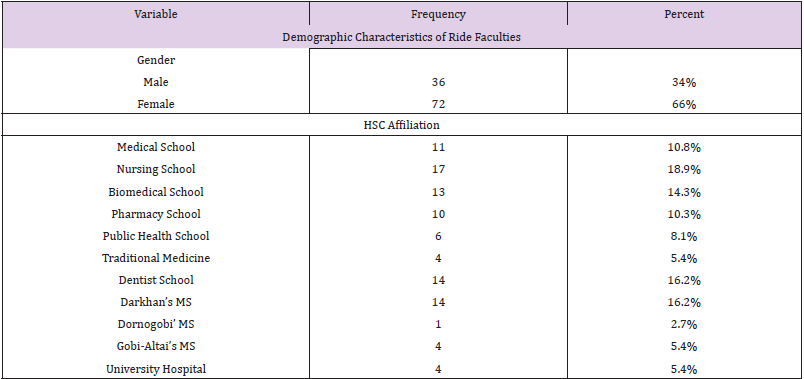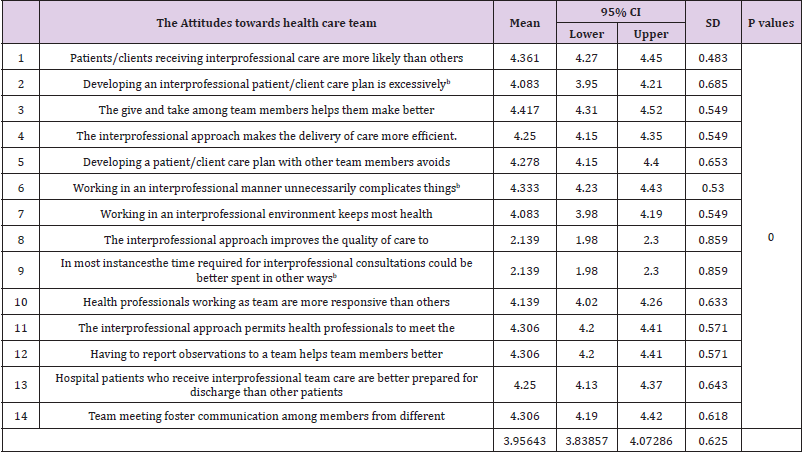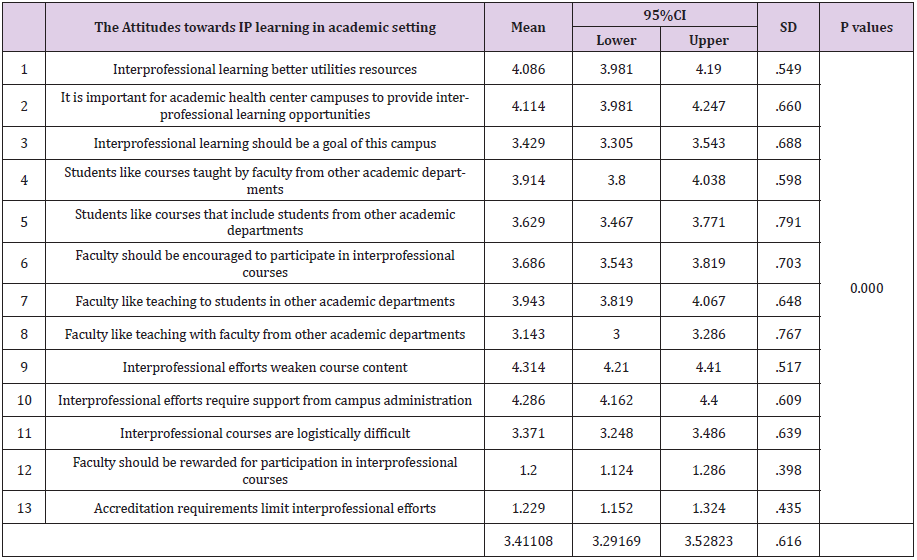Abstract
Introduction: Patient have complex health needs and typically require more than one discipline to address issues regarding their health status (Lumague et al.) Interprofessional education (IPE) is an approach to develop healthcare students for future interprofessional teams Interactive learning requires active learner participation, and active exchange between learners from different professions. The purpose of this study is to describe attitudes toward interprofessional education in Mongolian healthcare professionals.
Methods: Cross-sectional study, Curran et al and Gardner et al developed the Attitudes Toward Health Care Teams (ATHCTS, 14 items-IPC, 15 items-IPE, 13 items - IPLAS, 10 items for barriers) measured attitudes toward health care teams. This study was conducted in the 2019 academic year. During the first term, an attitudinal survey was administered to the health care professionals and supervised by the professors responsible for each health care professionals. Survey responses were always confidential and names and other identifying information were removed. Data combined from heath care professionals at MNUMS were analysed using the Statistical Package for the Social Sciences, version 23. The suitability of the correlation matrix was determined by the Kaiser- Meyer -Olkin estimate of sampling adequacy and Bartlett’s Test of Sphericity. The number of factors retained for the initial solutions and entered into the rotations was determined by application of Kaiser’s criterition (eigenvalues>1). To clearly define the structure, an exploratory factor analysis using warimax rotation was conducted. The level of significance was set at 5% for all tests. This study was approved by the Research Ethics Committee of Mongolian National University of Medical Sciences in Ulaanbaatar, Mongolia, 2019/3-08.
Results: Demographic characteristics of ride health care professionals are management’s team 6.3% (n=35), doctors 29.4% (n=163), nurses 56.9% (n=316), others 7.5% (n=41). As shown in attitudes toward health care team, the overall modified ATHCTS mean score of health care professionals at Mongolian National University of Medical Sciences (MNUMS) was significantly higher (3.8 ± 0.95, p<0.0001). The Kaiser- Meyer-Olkin index was 0.899, indicating sampling adequacy, and the Bartlett Sphericity Chi Square index was 1161.536 (p<0.0001). Cronbach’s alpha of the 14 items was 0.999, revialing a high rate of internal consistency. The modified ATHCTS questionnaire was categorized into the two factors “Quality of care” and “Team efficiency”. As shown in The Attitudes towards Interprofessional education, the overall modified mean score of health care professionals at MNUMS was significantly higher (3.9± 1.21, p<.0001). The Kaiser- Meyer-Olkin index was 0.888, indicating sampling adequacy, and the Bartlett Sphericity Chi Square index was 1842.086 (p<0.0001). Cronbach’s alpha of the 15 items was 0.794, revialing a high rate of internal consistency. The modified 15 item questionnaire was categorized into the two factors “Expertise” and “Competency”. As shown in The Attitudes towards IP learning in academic setting, the overall modified mean score of faculties at MNUMS was significantly higher (3.8 ± 1.12, p<0.0001). The Kaiser-Meyer-Olkin index was 0.884, indicating sampling adequacy, and the Bartlett Sphericity Chi Square index was 2451.053 (p<0.0001). Cronbach’s alpha of the 13 items was 0.918, revialing a high rate of internal consistency.
Conclusion: In conclusion, international research study’s result showed for important of IPE. In contrast to Mongolia our, the inclusion of interprofessional, health care professionals-led IPE programs should be developed through identified proponents of IPE initiatives. Results suggest that health care professionals in Mongolia could learn, at least in part, about CP through on-site practical training. IPE programs may be useful in learning about team efficiency in addition to strengthening attitudes toward the value of IPE to health care providers and receivers among undergraduate students.
Keywords: Health Care Professionals; Interprofessional Education; Attitudes; Interprofessional Health Care
Abbreviations:IPE: Interprofessional Education; CAIPE: Centre for the Advancement of Interprofessional Education; WHO: World Health Organization; SPSS: Statistical Package for the Social Sciences; MNUMS: Mongolian National University of Medical Sciences
Introduction
Many countries use the term “interprofessional education” and address collaboration and the patient perspective, such as the Australian Health Department which defines interprofessional education (IPE) as: “A collaborative, interdisciplinary education and learning process designed to produce effective, multidisciplinary patient-centered care”. One definition that seems clearer, more manageable and closer to the focus of our project is the Centre for the Advancement of Interprofessional Education (CAIPE) definition: “Occasions when two or more professions learn with, from and about each other to improve collaboration and the quality of care” [1]. Implementing IPE often relied on goodwill between teachers of different professions, between university and practice, and between facilitators and students [2]. Within the theoretical perspective of activity theory, it can be argued that the most troublesome challenges in relation to implementing IPL could be embraced as contradictions that may lead to change [3]. Patients have complex health needs and typically require more than one discipline to address issues regarding their health status (Lumague et al.) [4]. The World Health Organization (WHO) recommends that institutions engaged in health professional education and training consider implementing interprofessional education (IPE) in both undergraduate and postgraduate programs (WHO, 2013) [5]. The purpose of this study was to investigate the attitudes of faculties at MNUMS toward IPE.
Materials and Methods
Study Design and Participants
A descriptive, cross-sectional design was used to survey participants from a convenience sample of faculty at the Mongolian National University of Medical Sciences (MNUMS) located within a large university system in the Mongolia. The colleges represented were medicine, dentistry, nursing, pharmacy, public health, biomedicine and traditional medicine. An email was distributed to all MNUMS faculties inviting potential participants to complete an online survey. The survey instrument contained four scales to evaluate faculty attitudes toward IPE and teamwork adapted from the methods of Curran et al. [6]. Each scale asked respondents to rate their attitudes towards statements on a 5-point Likert scale (1=strongly disagree; 2=disagree; 3=neutral; 4=agree; 5=strongly agree). First, fourteen items were in field of attitudes towards interprofessional health care teams scale gauged how faculty feel about interprofessional health care teams, such as participation of three or more professions in collaborative patient care. Secondly, fifteen items in attitudes towards IPE to students’ development as health care professionals, specifically in relation to shared learning activities involving students from more than one health care professional program were included.
Ethical Considerations
This study was approved by the Ethics Committee of MNUMS (Approval number №8/3/2019-6-21).
Statistical Analysis
The data were analyzed using Statistical Package for the Social Sciences (SPSS), version 23.0J. Assumptions for parametric testing were met for multiple regression; a priori α level was set at 0.05. The predictor variables for each analysis included school affiliation (medicine, biomedicine, nursing, dentistry, pharmacy, public health, traditional medicine). Outcome variables were interprofessional learning in the health care setting, IPE and interprofessional health care teams. The scale was subject to exploratory factor analysis to examine the underlying constructs of the survey. The suitability of the correlation matrix was determined by the Kaiser-Meyer-Olkin estimate of sampling adequacy and Bartlett’s Test of Sphericity. The number of factors retained for the initial solutions and entered the rotations were determined with application of Kaiser’s criterion (eigenvalues>1). The initial factor extractions were performed by means of principal components analysis. To define the structure clearer, an exploratory factor analysis using varimax rotation was conducted. The level of significance was p<.0001 for all tests [7-10].
Results
The survey was completed by 10.8% of the faculty members from medicine, 18.9% of the faculty of nursing, 14.3% biomedical, 10.3% pharmacy, 8.1% public health, 5.4% traditional medicine (5.4%), and 16.2% of the faculty of dentistry. The survey was completed by 16.2% of faculty of the Darkhan’s medical school (16.2%), 2.7% of Dornogobi’s medical school (2.7%), 5.4% Gobi- Altai’s medical school (5.4%) and 5.4% of the faculty members of the University Hospital in Ulaanbaatar (Table 1). As shown in Table 2, the overall modified ATHCTS mean score of faculties at Mongolian National University of Medical Sciences (MNUMS) was significantly higher (4.0 ± 0.62, p<.0001). The Kaiser-Meyer-Olkin index was 0.511, indicating sampling adequacy, and the Bartlett Sphericity Chi Square index was 547.486 (p<0.0001). Cronbach’s alpha of the 14 items was 0.811, revialing a high rate of internal consistency. The modified ATHCTS questionnaire was categorized into the two factors “Quality of care” and “Team efficiency” (Table 2).
Table 2: The Attitudes towards health care team(Curran, 2007).
bNegatively worded items were reverse scored to calculate.
As shown in Table 3, the overall modified mean score of faculties at MNUMS was significantly higher (3.8 ± 0.61, p<.0001). The Kaiser-Meyer-Olkin index was 0.524, indicating sampling adequacy, and the Bartlett Sphericity Chi Square index was 575.701 (p<0.0001). Cronbach’s alpha of the 15 items was 0.847, revialing a high rate of internal consistency. The modified 15 item questionnaire was categorized into the two factors “Expertise” and “Competency” (Table 3). As shown in Table 4, the overall modified mean score of faculties at MNUMS was significantly higher (3.4 ± 0.61, p<.0001). The Kaiser-Meyer-Olkin index was 0.505, indicating sampling adequacy, and the Bartlett Sphericity Chi Square index was 388.330 (p<0.0001). Cronbach’s alpha of the 13 items was 0.812, revialing a high rate of internal consistency (Table 4).
Discussion
The present results showed that the overall mean modified attitude toward IPT and attitude toward IPE score of faculties was significantly higher of faculties at MNUMS. Factor analysis revealed two factors in the modified ATHCTS used here. The factor mean score for ‘Quality of care “of faculties was significantly higher than that mean score for “Team efficiency” and the modified 15 item questionnaire was categorized into the two factors mean score for “Expertise” and “Competency” of faculties was significantly higher. The factor mean score for “Faculty should be rewarded for participation in interprofessional courses”, and “Accreditation requirements limit interprofessional efforts” of faculties was significantly positive attitudes, while there was no significant difference (1.2) [11-14].
Concluding Comments
In conclusion, international research study’s result showed for important of IPE. In contrast to Mongolia our, the inclusion of interprofessional, faculty-led IPE programs should be developed through identified proponents of IPE initiatives. Results suggest that faculties and students in Mongolia could learn, at least in part, about CP through on-site practical training. IPE programs may be useful in learning about team efficiency in addition to strengthening attitudes toward the value of IPE to health care providers and receivers among undergraduate students.
Conflict of Interest
The authors state no conflict of interest and are responsible for conducting the study and writing the content of this report.
Acknowledgement
We would like to express to our gratitude to the administration Mongolian National University of Medical Sciences. We also thank all faculty and professors of MNUMS.
References
- Howkins E, Bray J, Barr H (2008) Preparing for Interprofessional Teaching. 3.
- Forman D, Jones M, Thistlethwaite J (2016) Leading Research and Evaluation in Interprofessional Education and Collaborative Practice. London, UK: Springerp. 46-47.
- O’Keefe M, Ward H (2018) Implementing interprofessional learning curriculum: How problems might also be answers. BMC Med Educ 18(132).
- Curran VR, Sharpe D, Forristall J (2007) Attitudes of health sciences faculty members toward interprofessional teamwork and education. Med Edu 41(9): 892-896.
- Hayashi T, Shinozaki H, Makino T, Ogawara H, Asakawa Y, et al. (2012) Changes in attitudes toward interprofessional health care teams and education in the first- and third-year undergraduate students. J Interprof Care 26(2): 100-107.
- Distefano C, Zhu M, Mindrila D (2009) Understanding and Using factor Scores: Considerations for the Applied Researcher. PARE 14(4): 1-11.
- Bennet PN, Gum L, Linderman L, Lawn S, Mc Allister S, et al. (2011) Faculty perceptions of interprofessional education. Nurse Educ Today 31(6): 571-576.
- Gary L Dallaghan B, Hoffman E, Lyden E, Bevil C (2016) Faculty attitudes about interprofessional education. Med Educ Online.
- Carolyn G, Umland E, Lyons KJ (2012) Attitudes of Faculty and Students in Medicine and the Health Professions Toward Interprofessional Education. Allied Health 41(1): 21-25.
- Loversidge J, Demb A (2015) Faculty perceptions of key factors in interprofessional education. JInterprof Care 29(4): 298-304.
- Milot E, Dumont S, Aubin M, Bourdeau G, Azizah GM, et al.(2015) Building interfaculty interprofessional education curriculum: What can we learn from the universite Laval experience? Edu Health28(1): 58-63.
- Lee B, Celletti F, Makino T, Matsui H, Watanabe H (2012) Attitudes of medical school deans toward interprofessional education in Western Pacific Region countries. J Interprof Care 26(6): 479-483.
- Barker K, Oandasan I (2005) Interprofessional care review with medical residents: Lessons Learned, tensions aired-a pilot study. J Interprof Care 19(3): 207-214.
- Barr H, Koppel I, Reeves S, Hammick M, Freeth D (2005) Effective interprofessional education: argument, assumption and evidence. Oxford: Blackwell Publishing, UK.

 Research Article
Research Article



